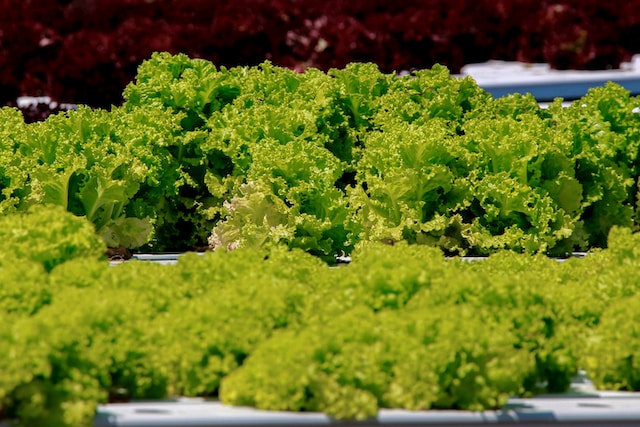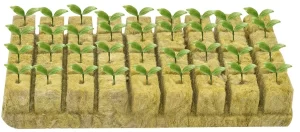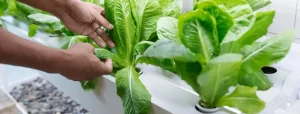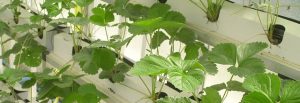Efficient Hydroponic Garden Setups – 2023

Table of Contents
Hydroponics is a method of growing plants without soil, in which plants are instead grown in a nutrient-rich water solution. It used to grow so many plants in different ways. Let’s dive in and learn more about hydroponic garden setups.
The roots of the plants are typically supported by a growing medium, such as perlite, coconut coir, or rockwool, which helps to anchor the plant and provide it with some physical support.
Hydroponic system allows for precise control over the growing environment, including temperature, humidity, and nutrient levels, which can lead to faster growth, higher yields, and greater crop consistency compared to traditional soil-based methods. This technique is used for both commercial crop production and home gardening.
Advantages of hydroponic system over traditional soil gardening
- Water conservation: Hydroponics systems use up to 90% less water than traditional soil-based gardening, as water is recirculated through the system rather than being lost through evaporation and drainage.
- Increased crop yields: With hydroponics, plants receive precisely the nutrients they need in the right proportions and at the right time, resulting in faster growth and higher yields compared to traditional soil-based gardening.
- No soil-borne diseases: Since hydroponics doesn’t use soil, the risk of soil-borne diseases is eliminated, making it possible to grow crops in areas where soil quality is poor or contaminated.
- Space efficiency: Hydroponics systems can be set up in a variety of indoor and outdoor spaces, including urban areas with limited space, allowing for year-round crop production.
- Reduced use of pesticides: Since hydroponic systems are contained environments, there is less need for pesticides and other chemicals, leading to healthier and safer produce.
- Sustainability: Hydroponics systems can be designed to be highly sustainable, using renewable energy sources and minimizing waste and environmental impact.
Types of hydroponic systems
There are several different types of hydroponic systems, each with its own unique advantages and disadvantages. Some of the most common types of hydroponic systems include:
- Deep water culture (DWC): In this system, plants are suspended in a nutrient-rich water solution, with their roots submerged in the water. An air pump provides oxygen to the roots, which helps promote healthy growth.
- Nutrient film technique (NFT): This system involves a thin film of nutrient-rich water flowing over the roots of the plants, which are typically held in small baskets or cups. The nutrient solution is constantly recirculated, providing a constant supply of fresh nutrients to the plants.
- Drip irrigation: In this system, nutrient solution is dripped onto the roots of the plants from a reservoir above them. The excess solution drains back into the reservoir for reuse
- Aeroponics: In this system, plants are suspended in air and their roots are misted with a nutrient solution. This allows for maximum oxygenation of the roots, which can lead to faster growth and higher yields.
- 5. Wick system: In this simple system, a wick (such as cotton or nylon) is used to draw nutrient solution from a reservoir into the growing medium, providing a constant supply of nutrients to the plants.
- Each type of hydroponic system has its own unique advantages and disadvantages, and the best system for a particular application will depend on factors such as the type of plants being grown, available space, and budget.

Components of a hydroponic garden setup
- Growing container: This is the container in which the plants will be grown. It can be a reservoir, bucket, trough, or other container that can hold the nutrient solution.
- Growing medium: This is the material in which the plants will be rooted. Examples of growing media include clay pebbles, rockwool, coconut coir, perlite, or vermiculite. The growing medium should be porous and able to retain moisture and nutrients.
- Nutrient solution: This is the water-based solution that contains the necessary nutrients for plant growth. The nutrient solution should be pH-balanced and contain the right amounts of nitrogen, phosphorus, potassium, and other essential minerals.
- Pump and tubing: This is the equipment that circulates the nutrient solution from the reservoir through the growing medium and back again. The pump should be sized appropriately for the size of the garden and the length of tubing needed.
- Lighting: Plants grown hydroponically require artificial lighting to simulate natural sunlight. LED, fluorescent, and HID grow lights are commonly used.
- Timers and controllers: These devices automate watering and lighting cycles, allowing for precise control of the growing environment. They can be used to adjust the timing and intensity of the lighting, as well as the frequency and duration of nutrient solution delivery
Steps to setting up a hydroponic system garden
- Choose the type of hydroponic system you want to use based on your available space, budget, and the type of plants you want to grow.
- Select a suitable location for your hydroponic garden. It should be an area that receives adequate lighting, is well-ventilated, and is protected from temperature extremes.
- Choose the plants you want to grow and select a suitable nutrient solution for their growth stage.
- Set up the growing container and fill it with your chosen growing medium.
- Install the water pump and tubing, ensuring they are properly sized for the size of the garden and the length of tubing needed.
- Add the nutrient solution to the reservoir and adjust the pH to the optimal level for your chosen plants.
- Install the lighting system and set it up to provide the appropriate amount and duration of light for your plants.
- Set up timers and controllers to automate watering and lighting cycles
- Plant your chosen seeds or seedlings in the growing medium, making sure they are properly spaced and supported.
- Monitor the nutrient solution and pH levels regularly, making adjustments as needed.
- Monitor plant growth and adjust lighting, nutrient levels, and other factors as needed to maximize plant health and yield.
Tips for successful hydroponic system gardening
- Start with a small hydroponic system: If you’re new to hydroponic gardening, it’s best to start with a small system to learn the basics before scaling up. This will help you avoid costly mistakes and give you the opportunity to experiment with different plants and nutrient solutions
- Choose the right plants: Not all plants are well-suited for hydroponic gardening. Choose plants that are fast-growing, compact, and have shallow root systems. Examples include lettuce, herbs, strawberries, and cherry tomatoes.
- Maintain proper nutrient levels: Nutrient levels in the water solution must be maintained at appropriate levels for optimal plant growth. Monitor pH levels and nutrient concentrations regularly, and adjust as necessary.
- Provide adequate lighting: Plants grown hydroponically require artificial lighting to simulate natural sunlight. Make sure your lighting system is appropriate for the size of your garden and the type of plants you’re growing.
- Keep the growing environment clean: Hydroponic system gardens are susceptible to algae, bacteria, and other contaminants that can harm plant growth. Regularly clean the growing container, tubing, and pump to prevent buildup and keep the system running smoothly.
- Monitor temperature and humidity levels: Temperature and humidity levels can affect plant growth and nutrient uptake. Keep the growing environment within the optimal range for your chosen plants.
- Avoid overwatering: Overwatering can lead to nutrient imbalances and root rot. Use timers to regulate watering cycles, and ensure that the growing medium is properly drained between waterings.
- Be patient: Hydroponic gardening requires patience and attention to detail. It may take some time to achieve optimal plant growth and yield, but with proper care and maintenance, your hydroponic garden can produce bountiful harvests of fresh, healthy produce
Conclusion
In summary, hydroponic system gardening offers a number of advantages over traditional soil gardening, including faster growth, higher yields, and better control over nutrient levels and growing conditions. Hydroponic gardening can be done in a small space and is an ideal option for those living in urban areas or with limited outdoor space.
With the right equipment and some basic knowledge, hydroponic gardening is an accessible and rewarding activity that can provide fresh produce year-round. Whether you’re interested in growing herbs, vegetables, or fruits, there’s a hydroponic system and plant variety to suit your needs.
If you’re interested in trying hydroponic gardening for yourself, there are a number of resources available online and in print to help you get started. Many gardening supply stores and online retailers offer hydroponic kits and equipment, and there are numerous blogs, forums, and YouTube channels dedicated to hydroponic gardening tips and tutorials.
So why not give hydroponic gardening a try? With a little patience and some experimentation, you may be surprised at how easy and rewarding it can be to grow your own fresh produce at home.




